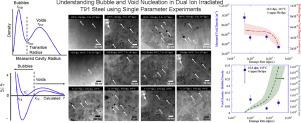当前位置:
X-MOL 学术
›
Acta Mater.
›
论文详情
Our official English website, www.x-mol.net, welcomes your feedback! (Note: you will need to create a separate account there.)
Understanding Bubble and Void Nucleation in Dual Ion Irradiated T91 Steel using Single Parameter Experiments
Acta Materialia ( IF 9.4 ) Pub Date : 2020-10-01 , DOI: 10.1016/j.actamat.2020.07.060 Stephen Taller , Gary S. Was
Acta Materialia ( IF 9.4 ) Pub Date : 2020-10-01 , DOI: 10.1016/j.actamat.2020.07.060 Stephen Taller , Gary S. Was

|
Abstract Ferritic-martensitic steels are attractive candidates for structural materials in next generation nuclear reactor systems due to their resistance to radiation induced swelling. Cavity and dislocation loop evolution was characterized in dual ion irradiated T91 steel in three separate irradiation campaigns examining single parameter dependencies of temperature, helium co-injection rate, and damage rate. Irradiations resulted in bimodal cavity size distributions across nearly all ranges of experimental parameters. It was determined that irradiation temperature and helium co-injection rate are stronger influences on bubble stability and the transition from bubbles to voids than is the irradiation damage rate. At low helium injection rates all helium is in vacancy clusters that evolve into bubbles or voids. At high helium injection rates, bubbles become saturated with helium resulting in accumulation of helium at other traps such as dislocation loops. At intermediate levels of He that should aid in the nucleation of bubbles and enhance swelling, the high density of sinks in the F-M microstructure suppresses bubble nucleation and therefore, the onset of swelling. At high enough temperatures, helium is only in bubbles as other strong helium traps, such as dislocation loops, did not form. The mechanism of bubble to void transition was found to shift from being driven by the accumulation of helium to the critical bubble at low damage rates to being driven by spontaneous formation by stochastic vacancy fluctuation at high damage rates.
中文翻译:

使用单参数实验了解双离子辐照 T91 钢中的气泡和空隙成核
摘要 铁素体-马氏体钢因其抗辐射引起的膨胀而成为下一代核反应堆系统结构材料的有吸引力的候选材料。双离子辐照 T91 钢在三个单独的辐照活动中的腔和位错环演化特征是检查温度、氦共注入率和损坏率的单个参数依赖性。辐照导致几乎所有实验参数范围内的双峰腔尺寸分布。确定辐照温度和氦气共注入速率对气泡稳定性和从气泡到空隙的转变的影响大于辐照损伤速率。在低氦注入率下,所有氦都处于空位簇中,这些空位簇会演变成气泡或空隙。在高氦气注入率下,气泡被氦气饱和,导致氦气在其他陷阱(如位错环)处积聚。在应该有助于气泡成核和增强溶胀的中等水平的 He 下,FM 微观结构中的高密度汇抑制了气泡成核,因此抑制了溶胀的开始。在足够高的温度下,氦气只会出现在气泡中,因为其他强氦陷阱(例如位错环)并未形成。发现气泡到空隙转变的机制从由氦积累驱动到低损伤率下的临界气泡转变为在高损伤率下由随机空位波动自发形成驱动。在应该有助于气泡成核和增强溶胀的中等水平的 He 下,FM 微观结构中的高密度汇抑制了气泡成核,因此抑制了溶胀的开始。在足够高的温度下,氦气只会出现在气泡中,因为其他强氦陷阱(例如位错环)并未形成。发现气泡到空隙转变的机制从由氦积累驱动到低损伤率下的临界气泡转变为在高损伤率下由随机空位波动自发形成驱动。在应该有助于气泡成核和增强溶胀的中等水平的 He 下,FM 微观结构中的高密度汇抑制了气泡成核,因此抑制了溶胀的开始。在足够高的温度下,氦气只会出现在气泡中,因为其他强氦陷阱(例如位错环)并未形成。发现气泡到空隙转变的机制从由氦积累驱动到低损伤率下的临界气泡转变为在高损伤率下由随机空位波动自发形成驱动。如位错环,没有形成。发现气泡到空隙转变的机制从由氦积累驱动到低损伤率下的临界气泡转变为在高损伤率下由随机空位波动自发形成驱动。如位错环,没有形成。发现气泡到空隙转变的机制从由氦积累驱动到低损伤率下的临界气泡转变为在高损伤率下由随机空位波动自发形成驱动。
更新日期:2020-10-01
中文翻译:

使用单参数实验了解双离子辐照 T91 钢中的气泡和空隙成核
摘要 铁素体-马氏体钢因其抗辐射引起的膨胀而成为下一代核反应堆系统结构材料的有吸引力的候选材料。双离子辐照 T91 钢在三个单独的辐照活动中的腔和位错环演化特征是检查温度、氦共注入率和损坏率的单个参数依赖性。辐照导致几乎所有实验参数范围内的双峰腔尺寸分布。确定辐照温度和氦气共注入速率对气泡稳定性和从气泡到空隙的转变的影响大于辐照损伤速率。在低氦注入率下,所有氦都处于空位簇中,这些空位簇会演变成气泡或空隙。在高氦气注入率下,气泡被氦气饱和,导致氦气在其他陷阱(如位错环)处积聚。在应该有助于气泡成核和增强溶胀的中等水平的 He 下,FM 微观结构中的高密度汇抑制了气泡成核,因此抑制了溶胀的开始。在足够高的温度下,氦气只会出现在气泡中,因为其他强氦陷阱(例如位错环)并未形成。发现气泡到空隙转变的机制从由氦积累驱动到低损伤率下的临界气泡转变为在高损伤率下由随机空位波动自发形成驱动。在应该有助于气泡成核和增强溶胀的中等水平的 He 下,FM 微观结构中的高密度汇抑制了气泡成核,因此抑制了溶胀的开始。在足够高的温度下,氦气只会出现在气泡中,因为其他强氦陷阱(例如位错环)并未形成。发现气泡到空隙转变的机制从由氦积累驱动到低损伤率下的临界气泡转变为在高损伤率下由随机空位波动自发形成驱动。在应该有助于气泡成核和增强溶胀的中等水平的 He 下,FM 微观结构中的高密度汇抑制了气泡成核,因此抑制了溶胀的开始。在足够高的温度下,氦气只会出现在气泡中,因为其他强氦陷阱(例如位错环)并未形成。发现气泡到空隙转变的机制从由氦积累驱动到低损伤率下的临界气泡转变为在高损伤率下由随机空位波动自发形成驱动。如位错环,没有形成。发现气泡到空隙转变的机制从由氦积累驱动到低损伤率下的临界气泡转变为在高损伤率下由随机空位波动自发形成驱动。如位错环,没有形成。发现气泡到空隙转变的机制从由氦积累驱动到低损伤率下的临界气泡转变为在高损伤率下由随机空位波动自发形成驱动。


























 京公网安备 11010802027423号
京公网安备 11010802027423号